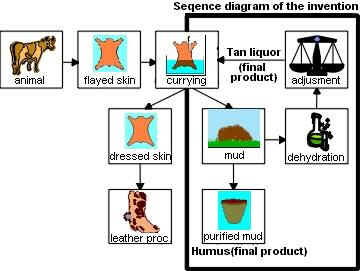The invention
- The problem
to be solved:
The different mud that remain after leather processing
and galvanisation technologies are hazardous
waste. The invention offers solution for the
extraction of metals and the utilisation of the
remaining mud with an environment friendly technology. The results are given back
to the industry and agriculture for reuse.
|
- Definition:
The mud containing heavy metals are
treated in two phases after the filtering. The
filtrate with the help of electrolysis and
osmosis, after the parameters are adjusted, is
given back to the factories for reuse. The heavy
metals are cleared off from the dry material with
washing in pulsating electric field and with pH
adjustment. The mud containing no metal is
utilised as humus, while the washing liquid is
handled together with the filtrate.
|
- Presentation:
The pH of the chromic mud is adjusted to
1.5 with sulphuric acid, and under constant
stirring the temperature is kept at 50 – 80 C° for 1.5 hours, while flocculating
agent is added as well. Afterwards the suspension
is filtered, and then after electroflotation
(which is microelement filtration) it is
dehydrated through osmosis. After the
concentration process the chemical adjustment
will follow (tan liquor H2SO4+Cr2
(SO4)3 and the recycled tan
liquor is returned to the leather industry. The
water produced during the concentration after the
osmosis will be utilised in the washing process.
The residual dry material will be washed after
homogenisation at pH 2 – 5, in a pulsating
electric field, at a 0 –80 V/cm field intensity
in every 10 –20 seconds. The washing process is
continued until the chromic content of the dry
material decrease under the permissible
1000-mg/kg value. The washing liquid is also
concentrated by the help of osmosis, and the
resulting solution, which contains chrome, will
be adjusted at the same level that of the tan
liquor and will be returned to the washing cycle.
The cleaned dry material is mixed with humite,
and straw and can be utilised in the agriculture
as humus. In case the tan liquor cannot be
returned into the leather processing technologies
as it is, than from the concentrated chrome III
solution chome alumen (KCr(SO4)2-12H2)
is produced, that is neutralised with potassium
carbonate, or potassium hydroxide added, and
after evaporation, and cooling the chome alumen
is filtered.

|
- Application: Environmentand
recycling.
|
- Advantages:
The protection of the environment. The reuse,
recycling of hazardous wastes in an environment
friendly way. The production of useful recycled
materials from the waste for the industry and the
agriculture. The recycling reduces the amount of
the hazardous material input in waste management.
Economic advantages.
|
- Stage of
development:
Examined successful semi-plant experiment.
|
- Documentation
available: Yes; the experimental machine
will be exhibited during the fair
|
The inventor(s)
- Name(s): Zoltán
SZABÓ Dr.
- Self
introduction:
He borns on 26/05/1963 in Budapest, He is a
chemist. He is member of MAFE since 1991.
Inventions are mainly about the utilisation of
heavy metal muds. Disabled pensioner, inventor
with three children.
|
The protection
- Form: Exhibition
priority
- Priority: 04/05/2000
- Countries
where it is force:
|
| Business
intention: Finding the consumer, the buyer, the
investor or the initiator of the invention |
| Contact
|